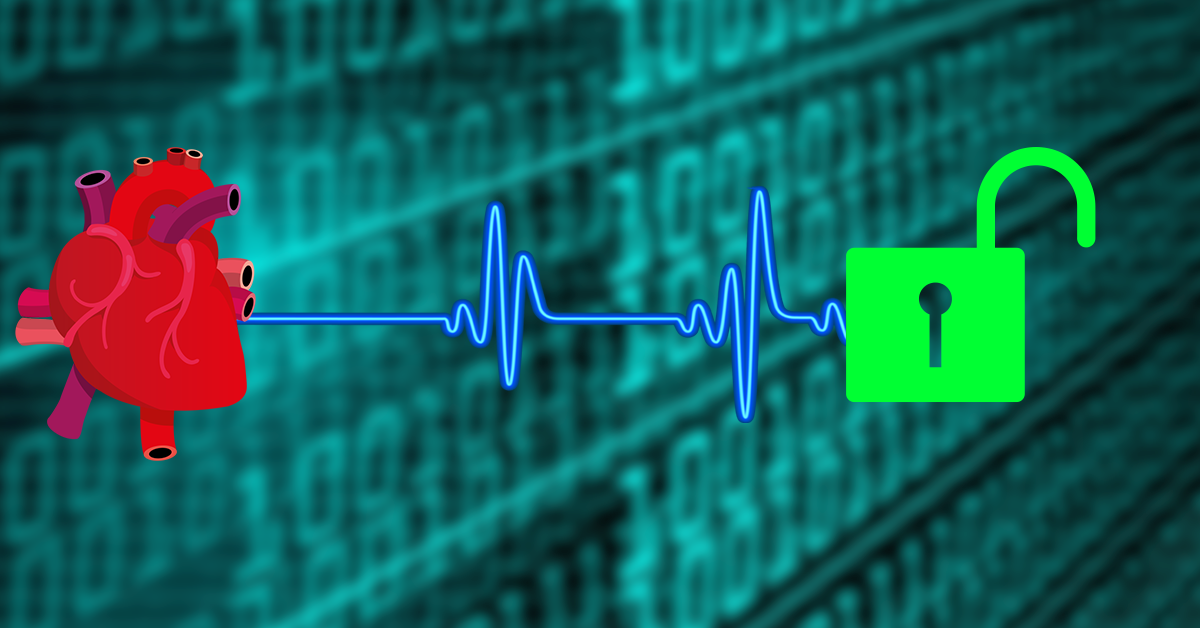
A patient’s own heartbeat could be used to secure their personal data, according to researchers at Binghamton State University, New York. This report comes after the claims that around 27 million health reports were undermined in 2016.
Read More: Hackers can replicate fingerprints from photos with peace sign
So how does this work? According to the researchers, a person has their own unique heartbeat and electrical activities associated with it. The electrical activity that occurs in a heart can be measured by an electrocardiograph. Basically, by measuring the electrical activity, the data that is obtained could be used to encrypt and secure an individual’s health records.
The electrocardiograph is used to collect heart signals during routine examinations of any disease. And since the system will already have the data, it can simply use it again to decrypt the health record. This simply reduces cost and time.
Zhanpeng Jin, assistant professor in the Department of Electrical and Computer Engineering, Binghamton University, said, “There have been so many mature encryption techniques available, but the problem is that those encryption techniques rely on some complicated arithmetic calculations and random key generations.”
However, it will be a long time before we see this technique being applied to unlock smartphones or other devices. Jin added, “If you apply those kinds of encryptions on top of the mobile device, then you can burn the battery very quickly.”
But why hasn’t this form of encryption technique been adopted everywhere? Well, simply because it has some drawbacks. The electrical activity of your heart changes depending on physical activity, mental condition, age, and other health-associated problems, thus making the technique more vulnerable and sensitive. But researchers are working on the ways this problem can be solved.
Jin also mentioned that ECG cannot be used as a biometric authenticator alone, but it can be used as a secondary authentication.
Currently, encryption and cryptography are used to secure health records. But these methods are time-consuming, expensive and computing intense.







![Best Gaming Laptops in Nepal Under Rs. 250,000 (रु 2.5 Lakhs) [2025] Best Gaming Laptops Under 2.5 lakhs in Nepal [Feb 2025 Update]](https://cdn.gadgetbytenepal.com/wp-content/uploads/2025/02/Best-Gaming-Laptops-Under-2.5-lakhs-in-Nepal-Feb-2025-Update.jpg)
![Best Gaming Laptops in Nepal Under Rs. 120,000 (रु 1.2 Lakhs) [2025] Best Budget Gaming Laptops Under Rs 120000 in Nepal 2025 Update](https://cdn.gadgetbytenepal.com/wp-content/uploads/2025/05/Best-Budget-Gaming-Laptops-Under-Rs-120000-in-Nepal-2024-Update.jpg)
![Best Laptops Under Rs. 80,000 in Nepal [2025] Best Laptops Under 80,000 in Nepal March 2025 Update](https://cdn.gadgetbytenepal.com/wp-content/uploads/2025/03/Best-Laptops-Under-80000-in-Nepal-March-2025-Update.jpg)
![Best Gaming Laptops in Nepal Under Rs. 200,000 (रु 2 Lakhs) [2025] Best gaming lapotp under 2 lakhs Nepal Feb 2025](https://cdn.gadgetbytenepal.com/wp-content/uploads/2025/01/Best-Gaming-Laptops-Under-2-Lakh-Nepal-Feb-2025-Update.jpg)

![Best Mobile Phones Under Rs. 15,000 in Nepal [Updated 2025] Best Phones Under 15000 in Nepal 2024 Budget Smartphones Cheap Affordable](https://cdn.gadgetbytenepal.com/wp-content/uploads/2024/03/Best-Phones-Under-15000-in-Nepal-2024.jpg)
![Best Mobile Phones Under Rs. 20,000 in Nepal [Updated] Best Mobile Phones Under NPR 20000 in Nepal 2023 Updated Samsung Xiaomi Redmi POCO Realme Narzo Benco](https://cdn.gadgetbytenepal.com/wp-content/uploads/2024/01/Best-Phones-Under-20000-in-Nepal-2024.jpg)
![Best Mobile Phones Under Rs. 30,000 in Nepal [Updated 2025] Best Phones Under 30000 in Nepal](https://cdn.gadgetbytenepal.com/wp-content/uploads/2025/01/Best-Phones-Under-30000-in-Nepal.jpg)
![Best Mobile Phones Under Rs. 40,000 in Nepal [Updated 2025] Best Phones Under 40000 in Nepal 2024 Smartphones Mobile Midrange](https://cdn.gadgetbytenepal.com/wp-content/uploads/2024/02/Best-Phones-Under-40000-in-Nepal-2024.jpg)
![Best Mobile Phones Under Rs. 50,000 in Nepal [Updated 2025] Best Phones Under 50000 in Nepal](https://cdn.gadgetbytenepal.com/wp-content/uploads/2025/01/Best-Phones-Under-50000-in-Nepal.jpg)
![Best Flagship Smartphones To Buy In Nepal [Updated] Best flagship phone 2025](https://cdn.gadgetbytenepal.com/wp-content/uploads/2024/07/Best-Flagship-Phones-who-is-it-ft-1.jpg)